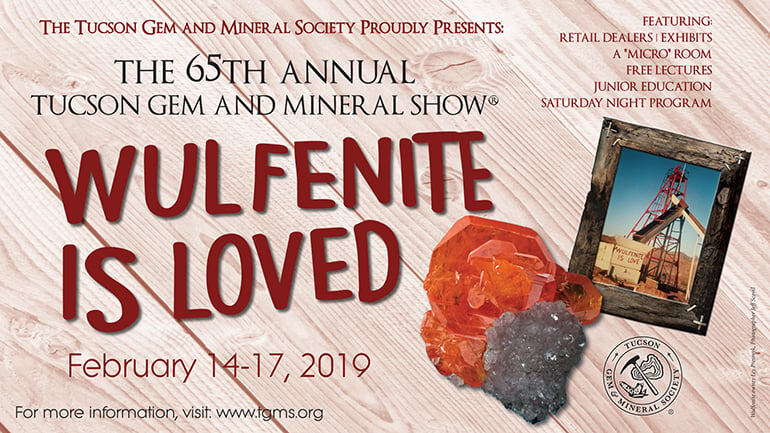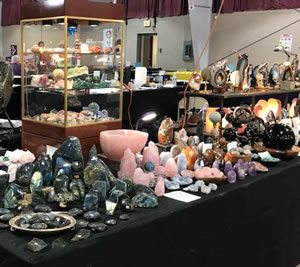 The A. E. Seaman Mineral Museum exhibited at the Kalamazoo Rock and Mineral Show May 3-5, 2019. This was the 60th anniversary of the show and instead of choosing a mineral as the show’s theme, the event celebrated the hobby of mineral collecting and the history of the show. The museum’s exhibit was titled “Semiprecious Gems.” Museum staff did not attend the show and instead shipped a carefully prepared exhibit with instructions for setup by a Kalamazoo club member. This is a cost-effective method to enhance the visibility of the museum. This year’s attendance at the Kalamazoo show was about 7,500, which includes 1,000 secondary school children and chaperones.
The A. E. Seaman Mineral Museum exhibited at the Kalamazoo Rock and Mineral Show May 3-5, 2019. This was the 60th anniversary of the show and instead of choosing a mineral as the show’s theme, the event celebrated the hobby of mineral collecting and the history of the show. The museum’s exhibit was titled “Semiprecious Gems.” Museum staff did not attend the show and instead shipped a carefully prepared exhibit with instructions for setup by a Kalamazoo club member. This is a cost-effective method to enhance the visibility of the museum. This year’s attendance at the Kalamazoo show was about 7,500, which includes 1,000 secondary school children and chaperones.

James DeGraff (EGM/EPSSI) is the Principal Investigator on a research and development project that has received $35,000 from the US Geological Survey.
This project is titled “Keweenaw Fault Geometry, Related Structures, and Slip Kinematics Along the Lac La Belle-Mohawk Segment, Michigan.” Chad Deering (EGM) and Aleksey Smirnov (EGM) are co-PI’s on this one-year project.
By Sponsored Programs.
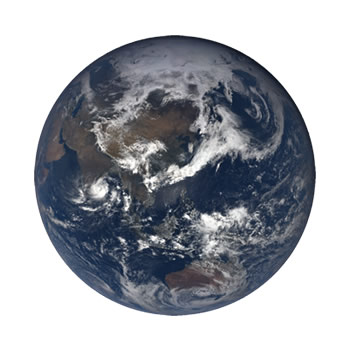
Simon Carn (GMES/EPSSI), is the principal investigator on a project that has received a $79,390 research and development grant from NASA. The project is entitled “Exploiting High-Cadence Observations of Volcanic Eruptions from DSCOVR/EPIC.”
This is the first year of a potential three-year project totaling $267,948.
By Sponsored Programs.
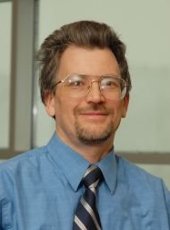
Aleksey Smirnov (GMS/EPSSI), is the principal investigator on a project that has received an $87,524 research and development grant from the National Science Foundation (NSF).
The project is entitled “Collaborative Research: Geomagnetic Field Strength and Stability Between 500 and 800 Ma: Constraining Inner Core Growth.”
This is the first year of a potential three-year project totaling $289,747.
By Sponsored Programs.
Extract
Earth’s magnetic field protects the planet from solar particles that would otherwise erode the atmosphere. Thus, the magnetic field is thought to be an essential factor ensuring long-term planetary habitability. Today, this geomagnetic field is powered by growth of the solid inner core. But thermal models suggest Earth has not always had a solid inner core; the time of the onset of inner core growth has ranged from 500 million to more than 2.5 billion years ago. This represents a fundamental unknown about the planet. Arguably the best way to investigate this question is to use “paleomagnetism”, the record of the ancient magnetic field trapped in rocks and crystals as they form. Such data have motivated the hypothesis that the geomagnetic field, and the magnetic shielding of the atmosphere from solar particles, almost collapsed 565 million years ago, but then the field slowly recovered. This event may record the birth of the solid inner core. This hypothesis will be tested through studies of rocks ranging in age from 800 to 500 million years old found in Australia, Canada and the United States. The collaborative work will involve a team of 5 scientists at 3 institutions (including an underrepresented minority and woman scientist), and will be integrated into education and outreach efforts at each university, including efforts to expand opportunities for first-generation and historically underrepresented individuals.
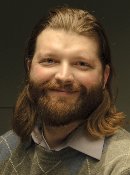
Geological and Mining Engineering and Sciences (GMES) adjunct assistant professor Luke Bowman gave a collaborative presentation titled, “Multidisciplinary, International Geological Hazards Research Experiences,” at the Geoscience and Society Summit, March 18 – 21, 2019, in Stockholm, Sweden. The Summit was part of a multi-year effort by organizers to articulate the roles of geoscientists in solving 21st Century challenges and reaching the United Nations’ Sustainable Development Goals (SDGs). The Summit was sponsored by the American Geophysical Union, Geological Society of America and the Bolin Centre for Climate Research.
Bowman presented the evolution of disaster risk reduction research by GMES students and faculty over the past three decades. The co-authors included professor and chair John Gierke, emeritus professor Bill Rose, associate professors Thomas Oommen and Greg Waite, and research assistant professor Rudiger Escobar-Wolf. The work that Bowman presented outlined a unique history of how GMES has actively broadened its faculty and student research interests to tackle societal issues in conjunction with the geophysical aspects of natural hazards in international settings.
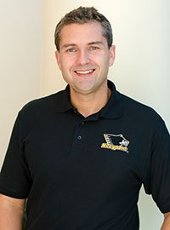
A study by Nathan Manser (GMES/EF) on human pathogen destruction in resource recovery systems is cited in the World Health Organization’s recent Guidelines on Sanitation and Health.
Manser ND, Cunningham JA, Ergas SJ, Mihelcic JR (2016). Modeling inactivation of highly persistent pathogens in household-scale semi-continuous anaerobic digesters. Environ Eng Sci. 33: 851-860.
The purpose of these guidelines is to promote safe sanitation systems and practices in order to promote health. They summarize the evidence on the links between sanitation and health, provide evidence-informed recommendations, and offer guidance for encouraging international, national and local sanitation policies and actions that protect public health. The guidelines also seek to articulate and support the role of health and other actors in sanitation policy and programming to help ensure that health risks are identified and managed effectively.
The A. E. Seaman Mineral Museum was exhibited at the 65th Annual Tucson Gem and Mineral Show held Feb. 14 -17, 2019. The Tucson show is the largest and most prestigious gem and mineral show in the world.
The theme of exhibits this year was “Wulfenite is Loved.” The museum’s exhibit fit with the theme and was titled “How does wulfenite form?” It featured text, graphics and mineral specimens to explain and illustrate the formation of wulfenite. Mineral specimens were used to emphasize how primary sulfide minerals are oxidized to form wulfenite. In addition, a suite of mineral specimens that form in the same environment and are associated with wulfenite were included in the exhibit.
The museum’s exhibit was awarded the “most educational exhibit by an institution” from Friends of Mineralogy, a non-profit, national organization founded in 1970.
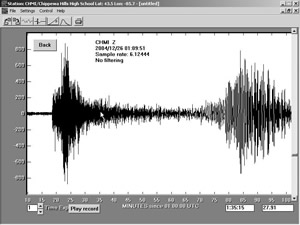 Kazuya Fujita, a professor in the Department of Earth and Environmental Sciences at Michigan State University, has been awarded the 2019 Charles A. Salotti Earth Science Education Award sponsored by the A. E. Seaman Mineral Museum and the Michigan Earth Science Teachers Association (MESTA).
Kazuya Fujita, a professor in the Department of Earth and Environmental Sciences at Michigan State University, has been awarded the 2019 Charles A. Salotti Earth Science Education Award sponsored by the A. E. Seaman Mineral Museum and the Michigan Earth Science Teachers Association (MESTA).
The award is in recognition of excellence in informal Earth science education and mentoring. This award has been made since 1999, with support of the Edith Dunn and E. Wm. Heinrich Mineralogical Research Trust, the A. E. Seaman Mineral Museum and the Salotti family.
Chuck Schepke, a secondary teacher in Roscommon, Michigan and past MESTA President, was the MESTA Chair of the Charles A. Salotti Earth Science Education Award committee. He cites Kazuya for his “efforts in organizing and supporting MiQuakes Teacher Seismology Network through MESTA and IRIS and providing Earthquake Workshops for K-12 teachers and these only begin to show the impact Kazuya has had on geoscience education in the State of Michigan and at the National level.
Fujita’s 25 years of service has provided teachers and their students the ability to collect and analyze “real-world” data from their own backyard through installation of seismographs in their classrooms and then mentoring teachers how to interpret data.”
Seaman Museum Executive Director Ted Bornhorst said “The museum is grateful for MESTA’s efforts at soliciting candidates for the award and selecting the awardee. This year’s awardee is most deserving of the honor. We hope that Professor Fujita’s work and this recognition may further inspire others to advance Earth science education and mentoring.”
By A. E. Seaman Mineral Musuem.
 Simon Carn (GMES) was quoted in the story “From NASA Goddard Space Flight Center: ‘2018’s Biggest Volcanic Eruption of Sulfur Dioxide,'” in sciencesprings. The story was also covered in Long Room, What’s Up with That? and Science Daily.
Simon Carn (GMES) was quoted in the story “From NASA Goddard Space Flight Center: ‘2018’s Biggest Volcanic Eruption of Sulfur Dioxide,'” in sciencesprings. The story was also covered in Long Room, What’s Up with That? and Science Daily.
From NASA Goddard Space Flight Center: “2018’s Biggest Volcanic Eruption of Sulfur Dioxide”
“With the Kilauea and Galapagos eruptions, you had continuous emissions of sulfur dioxide over time, but the Ambae eruption was more explosive,” said Simon Carn, professor of volcanology at Michigan Tech. “You can see a giant pulse in late July, and then it disperses.”
Read more at sciencesprings, by Jenny Marder.
Related:

Aleksey Smirnov (GMES) has been recognized as an Excellent Reviewer for 2018 by the Editorial Board of Earth, Planets, and Space (EPS).
EPS is the flagship journal of the Society of Geomagnetism and Earth, Planetary and Space Sciences, the Seismological Society of Japan, the Volcanology Society of Japan, and the Japanese Society for Planetary Sciences. It is an open access journal. All articles are made freely and permanently accessible online immediately upon publication.
It is essential for an academic journal to have qualified reviewers to maintain its scientific standard.
